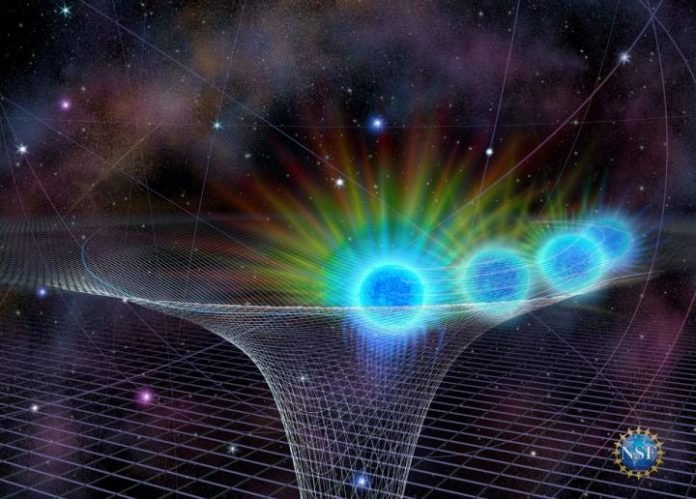
The enormous black hole at the center of our galaxy is having an unusually large meal of interstellar gas and dust, and researchers don’t yet understand why.
“We have never seen anything like this in the 24 years we have studied the supermassive black hole,” said Andrea Ghez, UCLA professor of physics and astronomy and a co-senior author of the research.
“It’s usually a pretty quiet, wimpy black hole on a diet. We don’t know what is driving this big feast.”
A paper about the study, led by the UCLA Galactic Center Group, which Ghez heads, is published in Astrophysical Journal Letters.
The researchers analyzed more than 13,000 observations of the black hole from 133 nights since 2003.
The images were gathered by the W.M. Keck Observatory in Hawaii and the European Southern Observatory’s Very Large Telescope in Chile.
The team found that on May 13, the area just outside the black hole’s “point of no return” (so called because once matter enters, it can never escape) was twice as bright as the next-brightest observation.
They also observed large changes on two other nights this year; all three of those changes were “unprecedented,” Ghez said.
The brightness the scientists observed is caused by radiation from gas and dust falling into the black hole; the findings prompted them to ask whether this was an extraordinary singular event or a precursor to significantly increased activity.
“The big question is whether the black hole is entering a new phase — for example if the spigot has been turned up and the rate of gas falling down the black hole ‘drain’ has increased for an extended period — or whether we have just seen the fireworks from a few unusual blobs of gas falling in,” said Mark Morris, UCLA professor of physics and astronomy and the paper’s co-senior author.
The team has continued to observe the area and will try to settle that question based on what they see from new images.
“We want to know how black holes grow and affect the evolution of galaxies and the universe,” said Ghez, UCLA’s Lauren B. Leichtman and Arthur E. Levine Professor of Astrophysics.
“We want to know why the supermassive hole gets brighter and how it gets brighter.”
The new findings are based on observations of the black hole — which is called Sagittarius A*, or Sgr A* — during four nights in April and May at the Keck Observatory.
The brightness surrounding the black hole always varies somewhat, but the scientists were stunned by the extreme variations in brightness during that timeframe, including their observations on May 13.
“The first image I saw that night, the black hole was so bright I initially mistook it for the star S0-2, because I had never seen Sagittarius A* that bright,” said UCLA research scientist Tuan Do, the study’s lead author. “But it quickly became clear the source had to be the black hole, which was really exciting.”
One hypothesis about the increased activity is that when a star called S0-2 made its closest approach to the black hole during the summer 2018, it launched a large quantity of gas that reached the black hole this year.
Another possibility involves a bizarre object known as G2, which is most likely a pair of binary stars, which made its closest approach to the black hole in 2014. It’s possible the black hole could have stripped off the outer layer of G2, Ghez said, which could help explain the increased brightness just outside the black hole.
Morris said another possibility is that the brightening corresponds to the demise of large asteroids that have been drawn in to the black hole.
No danger to Earth
The black hole is some 26,000 light-years away and poses no danger to our planet. Do said the radiation would have to be 10 billion times as bright as what the astronomers detected to affect life on Earth.
Astrophysical Journal Letters also published a second article by the researchers, describing speckle holography, the technique that enabled them to extract and use very faint information from 24 years of data they recorded from near the black hole.
Ghez’s research team reported July 25 in the journal Science the most comprehensive test of Einstein’s iconic general theory of relativity near the black hole.
Their conclusion that Einstein’s theory passed the test and is correct, at least for now, was based on their study of S0-2 as it made a complete orbit around the black hole.
Ghez’s team studies more than 3,000 stars that orbit the supermassive black hole. Since 2004, the scientists have used a powerful technology that Ghez helped pioneer, called adaptive optics, which corrects the distorting effects of the Earth’s atmosphere in real time.
But speckle holography enabled the researchers to improve the data from the decade before adaptive optics came into play.
Reanalyzing data from those years helped the team conclude that they had not seen that level of brightness near the black hole in 24 years.
“It was like doing LASIK surgery on our early images,” Ghez said. “We collected the data to answer one question and serendipitously unveiled other exciting scientific discoveries that we didn’t anticipate.”
Written by Stuart Wolpert.



